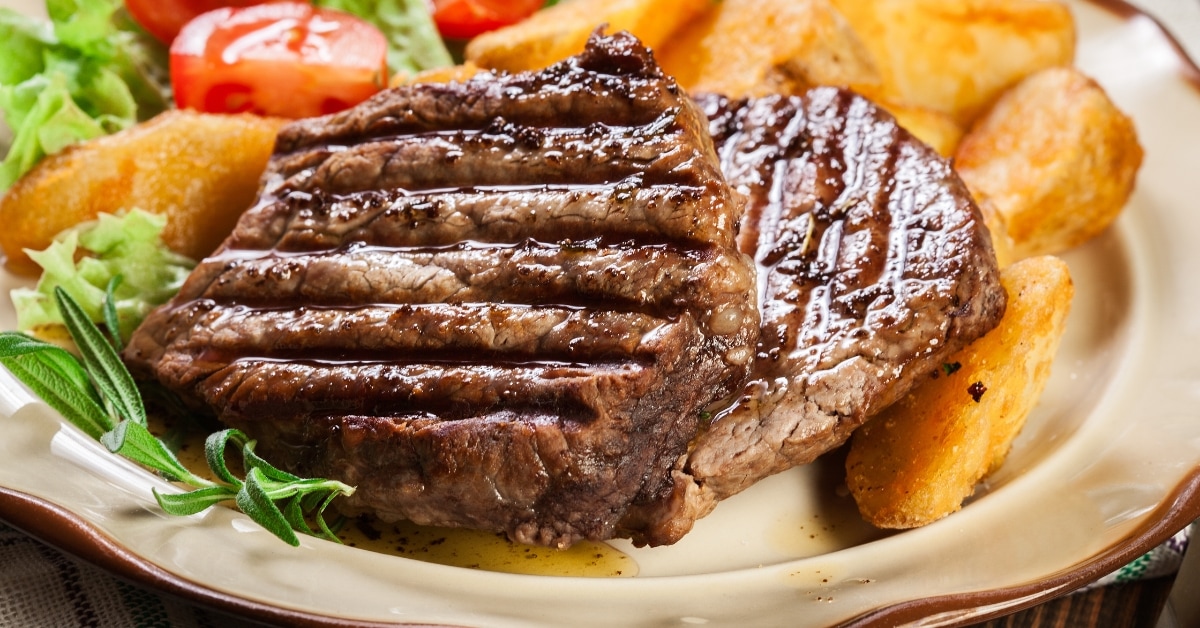Are you tired of dry, tough steaks? Then, you need to level up your cooking game and learn how to tenderize steak!
Knowing how to effectively break down muscle fibers can turn tough cuts into juicy, delightful bites.

All you need is a few basic tools, slicing techniques, and knowledge about cuts of meat.
And by learning about the methods below, you’ll be serving up restaurant-quality steak recipes in no time.
Keep reading to learn all there is to know about properly tenderizing steak!
What is Tenderizing?
When you bite into a delicious piece of meat, you want it to be soft, juicy, and tender, right?
But sometimes, the meat can be tough and chewy, making it difficult to enjoy.
That’s where tenderizing comes in!
Tenderizing is a process that helps break down the tough fibers in the meat. It makes the meat more tender, juicy, and enjoyable to eat.
There are plenty of different methods that you can do to tenderize steak.
From pounding to marinating and slow cooking, you’ll find the perfect way to match your preferences.

Should You Tenderize Steak?
Knowing how to tenderize steak can significantly enhance the flavor and texture of your dishes.
You can transform tough cuts of steak transformed into tender, juicy meals that will impress.
By learning about the different methods, you’ll feel like a pro in the kitchen. Plus, you can turn bland, boring steaks into something juicy, succulent, and flavorful.
So, why not try it and see how it can enhance your cooking skills?

Types of Steak to Tenderize
There are several different cuts of steak that can benefit from tenderization.
Here are some common types of steak that you might want to tenderize:
- Round steak: This cut comes from the cow’s rear leg and tends to be lean and tough.
- Chuck steak: Cut from the shoulder area, chuck steaks can be tough due to their higher collagen content.
- Skirt steak: This long, flat cut comes from the cow’s diaphragm and is known for its strong beefy flavor.
- Flank steak: Similar to skirt steak, flank steak is a thin, fibrous cut from the abdominal muscles of the cow.
- Hanger steak: This cut comes from the upper belly and is known for its rich flavor.
- Brisket: Brisket comes from the cow’s lower chest or breast area.
- Bottom round: This cut comes from the cow’s rear leg and is leaner than the top round.
- Tri-Tip steak: Tri-tip is a triangular cut from the bottom sirloin, known for its rich flavor.

How to Tenderize Steak
1. Pounding
Pounding steak is a great way to tenderize it and make it easier to chew.
It’s the most common way if you want a perfectly tender steak every time.
Place the steak between two pieces of plastic wrap or wax paper.
This step protects the meat and prevents any splattering.
Use a meat mallet or a rolling pin to pound the steak gently.
Start at the thickest part of the meat and work your way to the edges.
Be careful not to pound too hard, which can tear the meat. Flip the steak over and repeat on the other side.
If the steak is particularly tough, repeat the process a few times, adding extra force.
But remember to be gentle to avoid damaging the meat.
Once you’ve finished pounding, season the steak as desired and cook it as you normally would.
2. Salting
Salt is a magical ingredient in the culinary world.
And when it comes to tenderizing meat, you can’t go wrong with salting!
Salting is the process of coating the meat with salt to extract moisture.
It’s a simple technique that can take your steak from tough to juicy and succulent.
But wait, there’s more! Salting not only tenderizes your steak but also enhances the flavor.
Now, let’s get into the nitty-gritty of how to salt your steak.
Do this at least an hour before cooking to allow the salt to penetrate the meat.
First, pat your steak dry with a paper towel. This step will help the salt adhere to the meat better.
Then, completely cover both sides of the steak with kosher salt.
Don’t be afraid to use a lot of salt, as the meat will absorb most of it.
After an hour, rinse off the excess salt and pat the steak dry again. Now, your steak is ready to cook!
3. Marinating
Marinating is a fantastic way to infuse your steak with delicious flavors and tenderize it.
The process of marinating involves soaking your steak in a flavorful liquid mixture.
It helps break down tough muscle fibers in the meat, making it more tender and juicy.
The tender meat is achieved thanks to the help of the acidity in the marinade.
This process helps to break down the connective tissues in the meat.
The fun part of marinating is getting creative with your flavors and ingredients.
Depending on your preferences, you can use anything from herbs and spices to citrus juices and soy sauce.
4. Slow Cooking
Slow cooking is a fantastic way to turn a tough, chewy steak into a melt-in-your-mouth masterpiece!
Not only is it fun and easy, but it also yields flavorful and juicy results.
Coat your steak with braising mix and pop it in the slow cooker.
The key is to cook the steak at a low temperature for several hours.
The connective tissues break down as the steak cooks until it reaches the desired doneness.
5. Velveting
Are you ready to take your steak to the next level of tenderness? Then, you’ve got to try the process of velveting!
To velvet your steak, start by slicing it into thin strips against the grain.
It’s then added to a mixture of cornstarch or baking soda.
Compared to other methods, the marinade helps tenderize meat without adding additional flavors.
Let the steak rest for about half an hour, allowing the marinade to work its magic.
As the meat sits in the marinade, it will turn an intense red color. But this is nothing to worry about!
If you use baking soda, you can skip adding other seasonings.
But if you use cornstarch, you can create a mixture featuring your favorite herbs and spices.
6. Scoring
Unleash the full potential of your steak by scoring it before cooking!
So, what is scoring? It’s the act of making shallow cuts in the surface of the steak using a knife.
These cuts help to break down the muscle fibers, making the meat more tender.
To score your steak, hold your knife at a 45-degree angle to the surface of the steak.
Make shallow cuts about 1/8 to 1/4-inch deep and 1-inch apart across the surface.
This intricate pattern not only looks fabulous but also allows seasonings and marinades to penetrate better.
7. Letting the Steak Rest After Cooking
After cooking your steak, it’s hard to resist the mouthwatering aroma and sizzling meat on your plate.
But the one thing you should never skip is letting the steak rest before slicing!
Letting a steak rest after cooking allows the juices inside the meat to redistribute and reabsorb.
This step helps preserve the tenderness and flavor of the steak.










Didn’t tell me the seasoning to use to tenderize the meat.
Hi, Ramona!
There is no particular seasoning that you have to use. You can simply salt the steak with kosher salt and let it sit for about an hour (method 2). Or you can use cornstarch or baking soda to “velvet” the steak (method 5). Or you can let it sit in a marinade for several hours (method 3).
As for which marinade to use, that’s entirely up to you! I use a homemade marinade that I just kind of throw together. If you’d like that recipe, it’s:
4 tablespoons minced garlic (I sometimes use about 2 teaspoons of garlic powder instead.)
3 tablespoons Worcestershire sauce
5 tablespoons olive oil
1 tablespoon salt
2 teaspoons black pepper
a pinch of cayenne for heat
You mix everything together and pour it into a Ziploc bag. Then, add the steak and let it sit in the marinade for 4 hours to overnight. 🙂
Additionally, if you use cornstarch to “velvet” the steak, you can also add other seasonings, but again, the ones you use are entirely up to you. 🙂
Hi! Thanks for info on tenderizing steaks/venison etc. All this has been off my diet due to Crohns. My GI Dr in ‘96 told me red meat can take up to four days to digest so NO MORE!!! HOWEVER, my hubby needs it on his new diet for kidney disease. Of course I’ll check labels on all ingredients.
Thanks so much. Brenda w